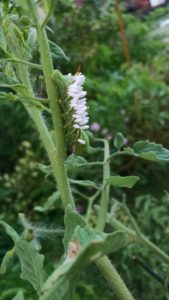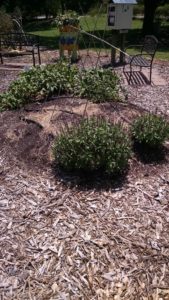The beetle that has infested this arugula (which is beyond saving, because of the spotting on the leaves), is yellow with dots on its back. It looks like the harlequin bug, which especially likes the cruciferous crops: cabbage family, mustard, turnip and radish. However, it has been known to munch on tomatoes, potatoes, eggplant, okra, and beans.
As you can see by the picture, there are brown spots on the leaves where the bug has sucked juices, which causes that portion of the leaf to die and turn brown. The life-cycle of the bug can be as short as 48 days, and so can have a number of generations go from egg to maturity during a growing season.
There are several control strategies. Hand-picking is first, but when there is a prolific infestation, it is difficult to pick all those little critters than can fly. A trap crop of turnip, mustard, or kale in the late spring or early fall could be used to attract them, but then the trap crop must be destroyed.
An organic spray can be made from insecticidal soap (which penetrates the hard shells) and neem oil. However, this is a control that must contact the bug or eggs, and is best applied in the early morning.
Prevention is perhaps the best method of control. Strong plants will tend to deter the bugs. This means encouraging deep roots through thorough watering. Also, the plants attractive to the harlequin bug are heavy calcium feeders. So, adding ground eggshells when planting may help prevent infestation.
Another preventive measure is to use row cover on the crops that don’t need pollination to grow. That means, the leafy crops like cabbage, arugula, mustard, kale, etc.
Companion planting can help too. Plants like basil, garlic, rosemary and sage, as well as chrysanthemum (with its natural pyrethrins) are strong-scented and mask the odors of the bug-targets. These companions can either be boundary plants or intermixed with the bug-targets.
Parasitoid wasps (attracted to yarrow, caraway and fennel, as well as other herbs with umbrella-like blooms) can be effective against the harlequin. If you purchase the wasps, be warned not to choose the braconid or trichogramma wasps, because they prefer soft-bodied pests rather than the hard-shelled harlequin.
References:
harlequin bug – Murgantia histrionica (Hahn) (ufl.edu)
12 Organic Ways to Control Harlequin Bugs – Hobby Farms
Barbara Pleasant, The Gardener’s Bug Book, Storey Publishing, 1994.




